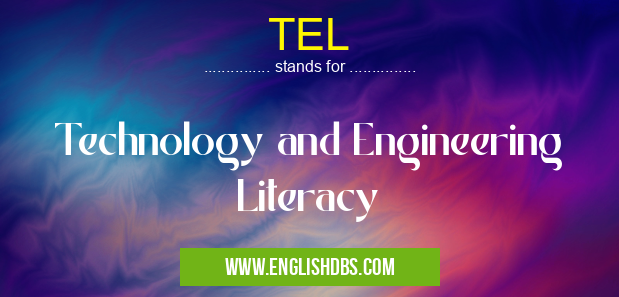What does TEL mean in ENGINEERING
Technology and Engineering Literacy (TEL) is a crucial educational discipline that focuses on developing students' understanding of the principles and applications of technology and engineering. It equips them with the knowledge, skills, and dispositions necessary to navigate the increasingly technological world they live in.

TEL meaning in Engineering in Academic & Science
TEL mostly used in an acronym Engineering in Category Academic & Science that means Technology and Engineering Literacy
Shorthand: TEL,
Full Form: Technology and Engineering Literacy
For more information of "Technology and Engineering Literacy", see the section below.
What is TEL?
TEL is an interdisciplinary field that integrates concepts from engineering, technology, science, and mathematics. It aims to:
- Foster students' understanding of the design process and engineering principles.
- Develop their problem-solving, critical thinking, and creativity skills.
- Cultivate their technological literacy and ability to use technology effectively.
Importance of TEL
TEL education is vital for preparing students for the 21st-century workforce and society. By developing TEL literacy, students gain:
- A foundation for careers in technology, engineering, and related fields.
- The ability to participate in informed discussions and decision-making about technological advancements.
- The skills to adapt to the rapidly evolving technological landscape.
Essential Questions and Answers on Technology and Engineering Literacy in "SCIENCE»ENGINEERING"
What is Technology and Engineering Literacy (TEL)?
Technology and Engineering Literacy (TEL) is an educational framework that emphasizes the understanding and application of technology and engineering concepts to solve real-world problems. It equips individuals with the knowledge, skills, and attitudes necessary to thrive in a technology-driven society.
Why is TEL important?
TEL is essential because it prepares individuals for the challenges and opportunities of the 21st century. It fosters critical thinking, problem-solving abilities, and creativity, which are highly valued in various fields, including engineering, design, and business.
What are the core components of TEL?
The core components of TEL include:
- Understanding of Technology: Knowledge of various technologies and their applications.
- Engineering Design: Ability to design and create solutions to technological problems.
- Problem Solving: Skills to identify, analyze, and solve problems using technological tools.
- Communication: Effectively communicating technological ideas and solutions.
- Ethical Considerations: Understanding the societal and ethical implications of technology use.
How is TEL taught in schools?
TEL can be integrated into various subjects, such as science, math, and social studies. It can also be taught through dedicated STEM (Science, Technology, Engineering, and Math) courses or extracurricular activities.
What are the benefits of TEL education?
The benefits of TEL education include:
- Enhanced critical thinking and problem-solving skills.
- Improved communication and collaboration abilities.
- Increased understanding of technological principles and applications.
- Development of creativity and innovation.
- Preparation for future careers in technology-related fields.
Final Words: TEL is an indispensable educational discipline that empowers students with the knowledge and skills they need to thrive in a technology-driven world. By integrating TEL into curricula, schools can prepare students to become technologically literate, innovative thinkers, and effective problem-solvers.
TEL also stands for: |
|
| All stands for TEL |
